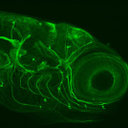Epstein-Barr virus myeloradiculitis and encephalomyeloradiculitis.
Түлхүүр үгс
Хураангуй
We provide a comprehensive clinical, radiological and virological analysis of four patients with Epstein-Barr virus (EBV) infection of the nervous system. One patient developed acute myeloradiculitis, one had acute encephalomyeloradiculitis, one had acute meningoencephalomyeloradiculitis and one had a subacute meningomyeloradiculitis. The ability of EBV to affect multiple parts of the entire neuraxis from meninges and brain to the spinal cord and peripheral nerves was evidenced by combinations of stiff neck and mental status changes, as well as patterns of weakness and sensory loss due to transverse myelitis or peripheral nerve disease. The CSF of all four patients contained a pleocytosis, predominantly mononuclear with elevated levels of protein, but a normal glucose level. In the two patients with acute myeloradiculitis and subacute meningomyeloradiculitis, the MRI revealed an increased signal in the spinal cord and lumbosacral roots, but in the two patients with acute encephalomyeloradiculitis and acute meningoencephalomyeloradiculitis, the brain and spinal cord MRIs were normal. In all four patients, EBV DNA, but not cytomegalovirus (CMV), herpes simplex virus (HSV) or varicella-zoster virus (VZV) DNA, was found in the CSF. The antibody pattern in serum was consistent with recent infection, and both EBV immunoglobulin (Ig) M and IgG antibodies, but not antibodies to HSV, VZV or CMV, were found in the CSF. Finally, there were reduced serum/CSF ratios of antibody to EBV, but not to total IgG or albumin, consistent with intrathecal antibody synthesis. None of the four patients died and none had brain swelling or focal changes according to brain MRI. Residual neurological deficits were evident. The two patients with acute myeloradiculitis and acute meningomyeloradiculitis had residual lower extremity weakness, and one of these patients later developed optic neuritis. The patient with acute encephalomyeloradiculitis had a moderate flaccid paraparesis, and the patient with subacute meningomyeloradiculitis was left with sensory loss in the feet. Compared with neurological disease caused by other herpes viruses, the clinical features of acute EBV myeloradiculitis, encephalomyeloradiculitis, encephalomyeloradiculitis and subacute meningomyeloradiculitis are distinctive. Of the eight human herpesviruses, EBV and VZV produce the most protean neurological syndromes. The mechanism by which EBV produces neurological disease is unknown. More correlative pathological, virological and immunological studies are needed in EBV-associated neurological disease.


